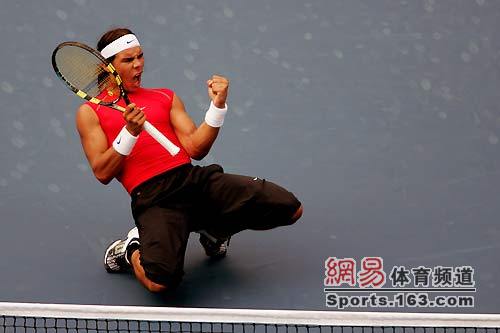
|

Nadal's Power and Style a Rare Combination
By HARVEY ARATON, New York Times
August 30th, 2005
RAFAEL NADAL will not be ignored, overlooked or difficult to locate.
He was the 6-foot swashbuckler in the white head wrap, the red muscle shirt and the black capri pants yesterday, toweling off his bulging, bronzed biceps between points during a 6-3, 6-3, 6-4 victory over the American wild-card entrant Bobby Reynolds in the first round of the United States Open.
Men's tennis hasn't seen an upper body quite like Nadal's, but don't be fooled by the stone-cut look - it's remarkably deceiving, stylistically speaking. Far from the indistinguishable cowboys in baseball caps, Nadal of clay-court land, more commonly known as Spain, is no generic power boy who is all serve and swagger, fire and forehand.
Based solely on his brief and modest hardcourt history, he is also no Andy Roddick. Yet with every passing month and each Roddick failure to dent the Roger Federer mystique, the perception grows that Nadal has surpassed him as the primary Tour contender.
After Nadal celebrated his 19th birthday by taking Federer out of the French Open semifinals on his way to his first Grand Slam title, Time magazine hailed the match as "spawning a rivalry with John McEnroe-Bjorn Borg potential." Federer, the reigning United States Open champion, called Nadal's unbridled athleticism mixed with wildly inventive shot-making extraordinary, though in an interview last week he was loyal to his peer group.
"Roddick will be unbeatable if he can serve and storm all the time," Federer said. "That's almost impossible, but that's something you have no control over. With Nadal, he lets you play, at least."
It's difficult to make the case for a Federer-Roddick rivalry, unless it's like Yankees-Red Sox (and Roddick has the one victory in 11 attempts to sustain that historical assessment). It is altogether premature to say that Roddick, who turns 23 today, is already over. But it's also on Roddick to head off Nadal in a potential semifinal here, assuming Nadal, who won his first hardcourt tournament this month in Montreal and nearly beat Federer in Miami last spring, is ready to make it that far.
"The hardcourt, if it's slow, is not too much difference than clay," Nadal said.
Asked if the blue cement at Arthur Ashe Stadium met that standard, Nadal said, "No, not too much, no."
Whatever was lost in translation, there is near-universal acknowledgment that Nadal is much more than what we have come to expect from the army of dirt-balling Spaniards in the mold of Carlos Moya, one of Nadal's heroes growing up on the island of Majorca. His pedestrian serve doesn't scare opponents, least of all Federer, but neither did Andre Agassi's, and he exploded on the tennis scene in much the same manner as Nadal and remains the only player of his generation to win all four Slam events.
Nadal's ascent to No. 2 in the rankings is another reminder of America's diminishing place in the tennis world order. Here at its own Grand Slam, the United States can boast of three seeded players apiece in the men's and women's draws out of 64 - and two of them, Agassi and Lindsay Davenport, are playing on a year-to-year basis.
American tennis has fallen a long, long way since 1987, Nick Bollettieri conceded, when his academy alone sprinkled the Open draws with 26 players. "You're seeing great athletes from all over the world going into tennis now, but in this country, the best athletes go into other sports," he said. "That's hitting the nail on the head."
Now Europeans dominate the draws, set the trends, dare to bare arms, especially since Nadal dominated the clay-court season and rocketed to French Open fame.
When Bollettieri finished a scheduled talk yesterday on how to nurture a budding tennis career to a group of youngsters in one of the Open's special activity areas, a slender teenage boy approached.
"How much time should you spend in the gym?" said the boy, Justin Coache, 16, of Bow, N.H.
"Tennis is a sport where you want to be flexible and fast," Bollettieri said. "You don't want to spend too much time in the gym. You don't want to become overmuscled."
"But what about Nadal?" the boy asked.
Good question.
Turns out that young Coache, a high school varsity player, watched Nadal practice during the weekend, and afterward coaxed him into posing for a photo. Startled by how scrawny his son looked next to Nadal - the way most tennis players do - Coache's father, Greg, said he wanted to learn more about whether bigger was necessarily better.
"If you can get that extra strength but stay flexible, I guess Nadal is proving that it may be," Bollettieri said. "But the most important thing now is that you have to be a great athlete."
That's hitting the nail on the Nadal. Muscled up top as he is, it'll be his legs that carry him as far as he's going to go. From a family of soccer players that produced one national team player, an uncle, Nadal's most compelling quality is not all that different than Federer's: he gets to balls most players give up on, and he has the racket control to make shots as colorful as his clothes.
**Please do not reproduce without giving credit to the original source and VamosRafael.com.**
Return to VamosRafael.com.
Return to VamosRafael.com Articles.


